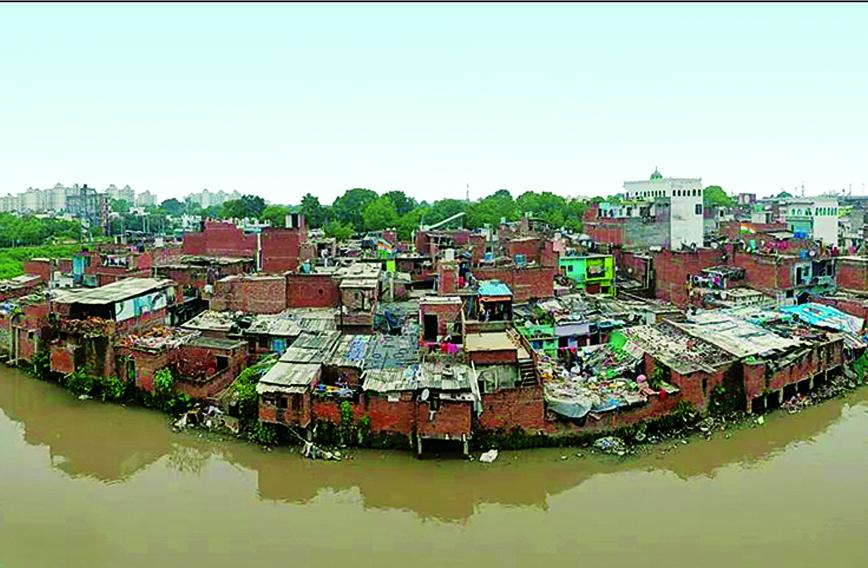
VENKATESH DUTTA
OVER the past two years, I have had the opportunity to meet with district magistrates (DMs) and chief development officers (CDOs) across 10 districts of Uttar Pradesh (UP), namely, Pilibhit, Lakhimpur Kheri, Sitapur, Lucknow, Hardoi, Rae Bareli, Unnao, Bahraich, Gonda and Mau. These meetings often culminated in day-long workshops on river and wetlands rejuvenation, attended by a diverse array of line officers such as sub-divisional magistrates (SDMs), deputy collectors, block development officers (BDOs) and engineers.
Through these discussions and fieldwork, a striking issue surfaced repeatedly — the rampant encroachment on lands that belonged to rivers and water bodies. The scale and complexity of encroachment was massive. The land parcels adjacent to rivers and wetlands were being grabbed on a daily basis, often without attracting any public outcry or attention.
The root of the problem lies in the ambiguous status of these ‘commons’. There are no clearly defined property rights attached to these vital waterscapes. Ownership remains murky. There are no comprehensive guidelines outlining their use.
During fieldwork, it was observed that many of the land parcels had been leased out to private individuals, and many of these temporary leases were never revoked. I urged the district magistrates to instal boundary markers — similar to those the railways use to safeguard their properties — to clearly demarcate floodplains and river boundaries and reassert public ownership.
We even embarked on an effort to map some smaller rivers, but the project quickly unravelled. Block-level officers gave up this crucial exercise, citing countless title disputes with private landowners. In one particularly shocking instance, a flowing river had been divided into multiple ‘gatas’ — land parcels, with sections of barren land inexplicably marked in the middle of the river.
Similarly, wetlands had been carved into private plots — a development paradox often encountered in all the districts, in contradiction of their ‘water state’.
As I dug deeper, a disturbing pattern began to emerge. These alterations — gradual in some cases, abrupt in others — were made by lekhpals, tehsildars and SDMs over the past four decades, often without any regard for the ecological nature of the land. It was hard to digest that a water body could be reclassified as a settlement unit. Worse yet, these actions flew in the face of multiple court orders intended to protect these precious resources. The scale of the land conflicts is not just a threat to rivers and wetlands but an indictment of local governance that has allowed such obvious disregard for nature’s boundaries.
The gradual nature of such land grabs over the decades points to a systemic exploitation of legal loopholes, often involving altered land records, ignored court orders, and unofficial land deals. The leasing of public lands to private individuals and builders without revoking those leases, and the lack of clear property rights over these commons, create an environment conducive to erasing of vital ecosystems.
Powerful interests — whether land developers or local elites — can manipulate weak enforcement mechanisms and the lack of transparency in acquiring valuable land, especially in areas that are difficult to monitor, like rivers and wetlands. Poor record-keeping and title disputes often make it difficult to enforce court orders. In many cases, land records are outdated or incorrect, leading to confusion about what constitutes a water body and who owns it.
I suggested installing marking pillars as a practical and effective way to define property rights of rivers, wetlands, and other commons. By physically demarcating the boundaries of these water bodies, including the ‘buffer land’, it would establish a clear, visible line between public and private land. The marked boundaries can be integrated into existing land records and cadastral maps, making future land disputes easier to resolve, as well as preventing future illegal alterations. I also suggested putting visible signboards in areas where land grab was frequent, stating that the land belonged to the government.
A comprehensive mapping and documentation exercise by the land revenue department would need to precede any demarcation to ensure that the correct boundaries were being marked. At several places, embankments with the excavated river silt were made, narrowing the rivers and legitimizing the false river boundaries. This also led to people extending their farmlands into the riverbeds.
Several court orders in India have emphasized the need to protect water bodies and explicitly ruled against altering their natural state. In a landmark case of a resort encroaching upon the land of the Beas river in Himachal Pradesh (M.C. Mehta v. Kamal Nath & Ors., 1996), the Supreme Court invoked the public trust doctrine, stating that the government holds natural resources, including rivers and water bodies, in trust for the public. The court ruled that such resources should not be privatized or altered in a way that harms public interest or ecological balance. The judgment emphasized that no one, including the government, has the right to transform a natural resource like a river for private gain.
Similarly, in the Hinch Lal Tiwari v. Kamala Devi (2001) case, the Supreme Court ruled against illegal encroachment upon and construction on a village pond in UP. The court ordered the removal of illegal constructions and stressed that such measures must begin at the grassroots. In the order, the SC mentioned that the forest, tanks, ponds and so on are nature’s bounty and maintain the delicate ecological balance. Therefore, they should not be used for non-environmental purposes, such as private construction. The Court reaffirmed the need to restore ponds, lakes, and rivers to their original state for public use and ecological benefit.
In 2017, the National Green Tribunal (NGT) directed states to identify, notify, and protect wetlands under the Wetlands (Conservation and Management) Rules, 2010. The NGT has consistently emphasized that water bodies cannot be altered or reclaimed for other land uses, as it would have devastating ecological consequences.
Despite such clear-cut court rulings, encroachment on ponds, lakes, and rivers continues unabated.
Venkatesh Dutta is a Gomti River Waterkeeper and a professor of environmental sciences at Ambedkar University, Lucknow
Comments
Currently there are no Comments. Be first to write a comment!




